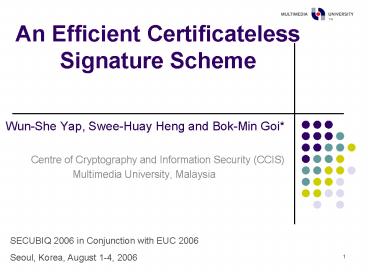An Efficient Certificateless Signature Scheme - PowerPoint PPT Presentation
1 / 17
Title:
An Efficient Certificateless Signature Scheme
Description:
Centre of Cryptography and Information Security ... What is Certificateless Public Key Cryptography? Introduced by Al-Riyami and Paterson in 2003 at Asiacrypt ... – PowerPoint PPT presentation
Number of Views:567
Avg rating:3.0/5.0
Title: An Efficient Certificateless Signature Scheme
1
An Efficient Certificateless Signature Scheme
- Wun-She Yap, Swee-Huay Heng and Bok-Min Goi
- Centre of Cryptography and Information Security
(CCIS) - Multimedia University, Malaysia
SECUBIQ 2006 in Conjunction with EUC 2006 Seoul,
Korea, August 1-4, 2006
2
Outline
- Introduction
- Contributions
- Generic Construction
- Security Model
- Concrete Scheme
- Analysis
- Conclusion
3
What is Certificateless Public Key Cryptography?
- Introduced by Al-Riyami and Paterson in 2003 at
Asiacrypt - Public keys used consist of 2 components ID and
self-generated public key - Private key partial private key and secret value
- Existing certificateless schemes
- Encryption
- Signature
4
- Advantages
- Implicit certification
- No certificate is needed in signing and
decrypting - No certificate management issues
- Free key escrow
- The Key Generation Center (KGC) cannot sign or
decrypt without knowing the users secret value,
and hence the users private key
5
Our Contributions
- We propose a certificateless signature (CLS)
scheme which is - Provable secure against existentially forgery on
adaptive chosen message and ID attacks (EUF-CMIA)
in random oracle model based on the
intractability of computational Diffie-Hellman
problem (CDHP) - More efficient (lesser bilinear pairing
computations and shorter public key length) - Achieve trust level 3
6
General Construction of CLS
- CLS is specified by seven algorithms
Remark These 2 steps are run by KGC
7
Remark These 3 steps are run by the user himself
8
(No Transcript)
9
Security Model of CLS
- Type I Adversary Can replace public key
- AI cannot extract the private key for IDch
- AI cannot request the private key for any ID if
the corresponding public key has been replaced - AI cannot both replace the public key for IDch
and extract the partial private key for IDch - AI cannot make a sign query on the forged message
for IDch - Type II Adversary Has access to master key
- AII cannot replace the public key at any point
- AII cannot extract the private key for IDch
- AII cannot make a sign query on the forged
message for IDch
10
Adaptive Chosen Message Attack Game
- Setup
- The challenger generates params and gives it to
the adversary A. If A is of Type II, the
master-key will be given to her too. - Attack
- A is allowed to make a sequence of requests
adaptively, each of which is either a Partial
Private Key Extraction, a Private Key Extraction,
a Request for Public Key, a Replace Public Key or
a Sign Queries, but are subjected to the rules on
adversary behaviors. - Forgery
- A outputs a certificateless signature on
message m signed by the user who holds IDA and
public key PA. The only restriction is that (m ,
IDA does not appear in the set of previous sign
queries.
s
11
Proposed CLS Scheme
- Setup
- G1, G2 generators of group G with prime order q
- e G1 X G1 ? G2
- P ? G1
- H1 0,1 ? G1, H2 0,1 X G1 ? Zq
- P0 sP, s ? Zq
- params (G1,G2,e,q,P,P0,H1,H2)
- master-key s
- Set-Partial-Private-Key
- QA H1(IDA) ? G1
- DA sQA ? G1
- Set-Secret-Value
- xA ? Zq
- Set-Private-Key
- SA xAQA DA
- Set-Public-Key
- PA xAP
Difference Public key no longer consists of 2
elements compared other existing CLS scheme
12
- Sign
- U rQA
- h H2 (mU)
- V (r h)SA
- Signature of m (U, V)
- Verify
- h H2 (mU)
- Check e (P, V) e (P0 PA, U hQA)
13
Analysis
- i. Correctness
- e (P, V) e (P, (r h) SA)
- e (P, (r h) (xAQA sQA))
- e (P, (r h) (xA s) QA)
- e ((xA s) P, (r h) QA)
- e (xAP sP, rQA hQA)
- e (P0 PA, U hQA)
14
ii. Performance
Table 1 Comparison of CLS Schemes
p Bilinear Pairing s scalar
multiplication e exponentiation
iii. Security The proposed CLS scheme is
existential unforgeable against the Type I
adversary and Type II adversary in the random
oracle model under the CDH assumption in G1.
15
Extended Construction
- 3 trust levels Level 1, Level 2 and Level 3
- Level 1 The authority knows the private keys and
is capable of impersonating any user without
being detected - Level 2 The authority does not know the private
keys, but it can still impersonate any user by
generating false certificates that may be used
without being detected - Level 3 The authority does not know the private
keys and if it generates false certificates for
users, it can be proven - Increase trust level 2 to 3
- How Binding technique which ensures that users
can only create one public key - Authenticate with KGC to fix PA xAP
- DA sQA where QA H1 (IDAPA)
- Disadvantage user no longer can regenerate
public key
16
Conclusion and Future Work
- Proposed a more efficient provably secure CLS
scheme against EUF-CMIA in the random oracle
model based on the intractability of CDHP - The scheme can achieve trust level 3 as that of a
traditional signature scheme - Efficiency of CLS can be further increased by
using key construction of Sakai-Kasahara IBE
scheme and Baek et al.s CLPKE scheme. - Future direction including proposing a provable
secure CLS scheme in standard model.
17
THANK YOU !

